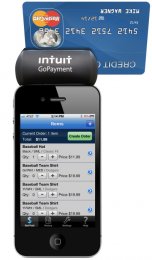Intuit POS GoPayment
 Let the mobile payment wars continue! Only yesterday Square announced its ever-expanding retail availability (20, 000 outlets nationwide), and today competitor Intuit GoPayment is following up with some major news of its own. Intuit is now merging its traditional POS software, QuickBooks POS, with its mobile offering (and Square rival) Intuit GoPayment.
Let the mobile payment wars continue! Only yesterday Square announced its ever-expanding retail availability (20, 000 outlets nationwide), and today competitor Intuit GoPayment is following up with some major news of its own. Intuit is now merging its traditional POS software, QuickBooks POS, with its mobile offering (and Square rival) Intuit GoPayment.
The two solutions will now be able to communicate with each other, syncing both inventory and financial data from PC to mobile or vice versa.
Intuit has been in the POS business for 10 years and its QuickBooks POS solution is aimed at the small to medium-sized business customer. Currently, the company has 200, 000 SMB retail customers who together reach 23 million customers across the U.S. Combined with GoPayment, the businesses process $6 billion in transactions annually.
Intuit GoPayment launched back in summer 2009, and now competes with Square, VeriFone’s PayWare, PayPal Here and many other “POS Light” solutions, as Chris Hylen, VP of Intuit Payments, calls them.
The GoPayment mobile app is free and the basic service includes no monthly transaction or cancellation fees. The swiped transaction rate is 2.7% for pay-as-you-go users, and, like Square, it has eliminated the per transaction fee. Intuit also offers a $12.95/month option, which reduces the swipe rate to 1.7%. QuickBooks POS users pay $19.95/month, and get a rate of 1.64% when using GoPayment. QuickBooks has increased pricing for its software by $100, based on enhancements offered. The GoPayment credit card readers will continue to be available for free.
Key to the integration are the two products’ ability to sync their data from PC to mobile or the other way around. With QuickBooks POS, businesses can manage multiple locations, track customers, create and management inventory, run reports, and more. There are also features that allow it to track employee clock-ins and clock-outs and automatically calculate commissions, as well as advanced controls which allow businesses to lock down permissions for certain tasks by user. (E.g., who can process returns, who can add inventory, etc.).






